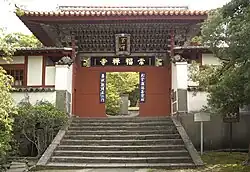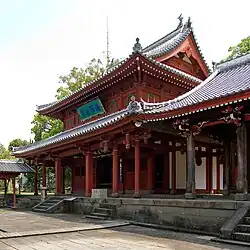Sōfuku-ji (Nagasaki)


Sōfuku-ji (崇福寺) is an Ōbaku Zen temple that was built by the Chinese monk Chaonian (Chozen) in 1629 as the family temple of the Chinese from Fuzhou, Fujian Province who settled in Nagasaki.[1][2]
Temple buildings
Two of its buildings have been designated as national treasures. The Daiyūhoden Buddha Hall is one of Nagasaki’s oldest buildings, having been designed in China. The sections of the temple were cut in China and then shipped to be assembled in Nagasaki in 1646.[3] The “Daiyū” in “Daiyūhoden” refers to the Sakyamuni Buddha which is enshrined in the hall as the principal image.[4]
The original entrance to the temple, the Dai-ipponmon gate was likewise shipped to Nagasaki from China, having first been built as the gate of a temple in China in 1644. It was reassembled at the entrance to Sōfuku-ji temple in 1695.[5]
The current red entrance gate, called the Ryugamon, or “Gate of the Dragon Palace”, is painted bright red and is a rare example of the architecture of South China during the Ming dynasty. It was originally built in 1673, but has been destroyed by fires and storms several times. The most current gate was built in 1849.[3]
Enshrined deities
The goddess of the sea, Maso, is enshrined in the Masodo, along with other life-sized statues in the main hall.[5] Maso is a Chinese goddess, who’s worship is based in coastal southern China, and was not taken up more generally in Japan, despite being popular with Chinese mariners who traded into Nagasaki.[6]
Other historical treasures
In the temple grounds is a large cauldron made by the resident priest Qianhai to cook gruel for people who were starving during the famine of 1681.[7]
The bell of the temple was cast in 1647.[3]
Festivals
The Chinese Bon Festival is held here from July 26 to 28 (by lunar calendar), with Chinese coming from all over Japan to participate in the ritual for the dead.
-
 Sanmon, gate
Sanmon, gate -
 Gate (Taisho)
Gate (Taisho) -
 Great Cauldron
Great Cauldron -
 Great Cauldron (Taisho)
Great Cauldron (Taisho) -
(video) Various views, 2016
Access
The temple is served by Sōfukuji terminus station on the number 1 and 4 tram lines.[3]
Opening times
The temple is open to visitors daily from 8AM to 5PM.[3]
See also
32°44′32″N 129°53′01″E / 32.74222°N 129.88361°E
References
- ^ "The first Chinese style temple in Nagasaki". japan-kyushu-tourist.com.
- ^ "Sofukuji Temple (崇福寺)". travel.navitime.com.
- ^ a b c d e "Sofukuji Temple". www.japan-guide.com. Retrieved 2025-08-11.
- ^ "Sofukuji Temple". 【公式】長崎観光/旅行ポータルサイト ながさき旅ネット. Retrieved 2025-08-11.
- ^ a b Reyes, Alma (2023-10-27). "Sofukuji Temple". GaijinPot Travel. Retrieved 2025-08-11.
- ^ "Sōfukuji: A Chinese Zen Temple (And Sea-Goddess Cult) In Nagasaki, Japan – David Hurley In Japan". davidhurleyinjapan.com. Archived from the original on 2025-06-22. Retrieved 2025-08-11.
- ^ "Sōfuku-ji | Nagasaki, Japan | Attractions". Lonely Planet. Retrieved 2025-08-11.